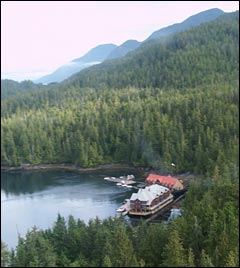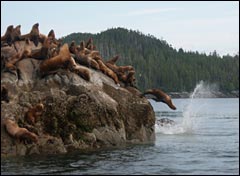
The Great Bear Rainforest, stretching from Vancouver Island to the Alaska Panhandle on the wild, rugged coast of British Columbia, is that rarest of things: an unvarnished environmental victory. But as the groundbreaking agreement signed to protect it comes into force, new challenges are surfacing.
The numbers are stunning: at 15.5 million acres, this rainforest is the size of Switzerland. A third of it, about the size of New Jersey, is now entirely protected from logging (selective cutting is permitted on the rest). The Great Bear is home to only about 25,000 people — and also a fifth of all the wild salmon on the planet. It is a rugged coast of narrow fjords that reach so far in from the sea, the water becomes glassy, as though in a lake. That water reflects steep mountainsides and glacier-smoothed peaks, their flanks cloaked in untouched coastal rainforest marked here and there by lighter patches of alder where rockslides have churned the landscape. Humpback whales breach in the shadow of ancient cedars and rare spirit bears — a local variety of black bear with fine, white fur — scoop salmon from pristine rivers.
It’s just obvious that it shouldn’t be clear-cut or mined or paved. The Great Bear is one of those last remaining truly wild places that offer a dash of hope to the human imagination. “It’s a place 99 percent of people will never go,” says Todd Paglia, executive director of San Francisco-based ForestEthics, which was instrumental in protecting the area, “but they want to know it exists.”
The campaign to protect the Great Bear sprawled across a decade of activism, democracy, negotiation, and enlightened self-interest. By the time a deal was announced in February, an unlikely quorum of First Nations, timber companies, environmental groups, towns, tourism operators, and the provincial government had not just come to imagine a different future for the Great Bear — the group had committed to bringing it about.
The deal was so revolutionary that an entirely new type of land management was brought to British Columbia to encompass it. Already, the Great Bear is being hailed as a model around the world, from Chile to Tasmania.
But now things get interesting. Having protected the forest on paper, these strange bedfellows have to work together to achieve something none of them has ever tried before: creating a sustainable future for the region. While they iron out their partnership and plans, they must also fend off an oil-transport project that could change everything.
“Our first ten years of work were really a campaign — negotiations to try and save this place,” says Paglia. “The next ten years are to make sure that deal gets enforced. It’s changed the way we think about our work, because if the Great Bear isn’t there in 20 years, then we haven’t achieved anything.”
Great Expectations
The communities living in the Great Bear include First Nations like the Gitga’at people, who live in the village of Hartley Bay, pop. 180. The residents here have always depended on the natural bounty of the ecosystem. Indigenous people have long fished its waters and hunted its lands. More recently, a bustling commercial fishery sustained the community. But no more. The fleet of seine boats at Hartley Bay — which has no cars and no roads, only wooden boardwalks, and sits nestled between high, forested mountains — has dwindled to a handful as fish stocks have declined.

As elsewhere in British Columbia, the combination of economic pressures, a history of poor relations between First Nations and the government, and the social problems faced by a community that has endured two or three generations of colonizing, genocidal government policies left the area open to the blandishments of timber companies. They promised jobs, if little else.
Other parts of the province have been devastated by industry — from the air, it looks like the mountains have been scraped clean — but the Great Bear has so far been too remote for more than a few scattered clear-cuts by small operators. So the land hasn’t been devastated, but the communities have hit hard times. And with no other options, the apparent windfall of destructive logging could become too attractive to resist.
Which is why permanent forest protection has to include a sustainable local economy with a vested interest in an intact ecosystem, something Paglia says has become the new focus of his work in the Great Bear. “We are looking at botanical products that go into health and beauty aids, at sustainable seafood, and other options,” he says. “We’re looking at creating a social venture to partner with the First Nations and other entrepreneurs to ensure this region has real sustainable jobs, and isn’t tempted to go back on its agreements.”
The agreement does allow for limited, selective logging under an overarching ecosystem-based management plan. A few such operations have begun, and they are dramatically different from the clear-cuts of the past: a few trees are selected, leaving enough standing timber that the untrained eye might not even notice the cut at all, even when it is new.
Tourism is another tantalizing possibility, but one with well-known destructive tendencies of its own. A million people a year pass through the Great Bear on cruise ships, but none of them stop, and not a dime is spent here by the cruise industry. A million people visiting Hartley Bay would clearly be problematic, but there are other options. “These boats are like traveling feedlots,” says Paglia. “They’re filled with Americans at the trough. At the very least, they ought to be buying the seafood — cruise ships can buy local.” To that end, the Gitga’at have built an experimental oyster farm in a secluded fjord.
Another option is the kind of less-destructive tourism that folks drawn by the area’s natural features can bring. The coast here is already an angler’s paradise, luring people from all over the world for once-in-a-lifetime experiences at remote lodges. But could visitors love this place to death?

King Pacific Lodge.
Fit for a King
Not far from Hartley Bay sits King Pacific Lodge, a capacious wooden structure built on top of an old logging barge. It floats just offshore at the head of a calm bay called Barnard Harbor, surrounded by the usual — but never, ever unimpressive — mountains and forest. With fast, rugged boats, a quiet spa, a restaurant serving delicate interpretations of local wild foods, and a helicopter for inland fishing and hiking, it’s ecotourism for the affluent.
“We’re in a perfect situation here to look at ecotourism in a less theoretical way,” says Michael Uehara, King Pacific’s president. “Tourism here has the potential to displace more extractive practices. But it certainly has the potential to become a love-it-to-death plunder too.”
In 1999, the lodge became the first business in the Great Bear to explicitly recognize indigenous residents’ title to the land: King Pacific signed a protocol with the Gitga’at and began paying a conservation fee for each guest. Other operators were outraged, but today, after a bruising battle for indigenous land claims in British Columbia, hundreds of businesses in the province, including at least 100 in the Great Bear, have signed protocols with First Nations.
The lodge employs Gitga’at people as boat pilots and fishing and nature guides, and has become a pillar of the local community: Uehara was even accorded the rare honor of being inducted into the Gitga’at Killer Whale Clan. But King Pacific, where rooms start at over $1,000 a night, raises the vexing question of elitism. Uehara makes no bones about it: “Very few people can afford to come here,” he says, “but very few people spending a lot of money has great economic impact with less total environmental impact. At least that’s what we hope.”
Certainly the approach has worked in the immediate area: the forest around King Pacific was once slated to be logged, and had been cruised for timber as recently as 1999. Yet today bald eagles still perch on tall snags overlooking the mouth of the rushing river there, watching the salmon mass for their run up to their ancestral spawning grounds.
Paglia recognizes that King Pacific and its devotees have a place in the bigger economic picture, but says more affordable options are a necessary part of protecting the area. “My friends aren’t going to go to King Pacific,” he says. “They would go and do a hut-to-hut kayak trip or go to a lower-end lodge and love it — they’d bring back part of the Great Bear. They’d continue to make a contribution, even if it’s a smaller one financially.”
But operational questions like this pale in comparison to a new, looming threat: Big Oil.
If the Loggers Don’t Get You, the Drillers Will
The parties involved with the Great Bear agreement seem to be warming to their new roles, but it may already be time to fall back into fighting mode. Like an unfortunate hiker trapped between a grizzly and a fat, juicy salmon, this forest just happens to sit between the Alberta oil sands, where an oil boom is under way, and China, whose growing economy is sucking in fuel from all directions.

Insert oil tanker here?
This year, Enbridge, the Calgary-based company that operates the longest system of oil pipelines in the world, unveiled plans to build a pipeline terminus at Kitimat, on a fjord almost 100 miles from the open ocean. The project would mean oil tankers would cruise this narrow channel daily for the next 50 years, carrying a million barrels of crude a day right past Hartley Bay, past the King Pacific Lodge, past the Gitga’at seaweed harvesting grounds and oyster farm, past the rocks covered in sea lions, and through this ancient forest.
“To picture an oil tanker in that landscape is enough to make you cry,” says Paglia. After a decade of struggle, and just a few months of apparent victory, people are exhausted, and have to force themselves to confront this new challenge. “I tell people you better enjoy your life while you can,” says Helen Clifton, a Gitga’at elder and Uehara’s Killer Whale mother. “I don’t know that we 180 people can stop anything.”
But Merran Smith, the ForestEthics campaigner based in Smithers, B.C., who was instrumental in shepherding the players toward the Great Bear agreement, is more optimistic. “A lot of things happened that people said could never happen,” she points out. “A decade ago the whole coast was slated to be logged. It was stopped because of the power of the people. Corporations appear to have power, but we can stop them.”
But it’s going to be a tough fight. Corporations can learn too, and there is a $4 billion project at stake. Can the ties forged in the local community take that on? So far, they have weathered the opening shots: after an initial meeting with Enbridge, King Pacific Lodge received two unsolicited buyout offers. “It’s blatant,” says Uehara of the company’s divide-and-conquer strategy. “They’re everywhere, and they’re very good at it.” But he’s staying: “On almost every level, the lodge is incompatible with tankers passing in front of it. I have nowhere to go. Where do I go from here?”
The bears and the salmon don’t have anywhere to go either, which is why people like Paglia are in it for the long haul too: “Our victories are temporary and our defeats are permanent,” he says, quoting David Brower. “There is never an end to the campaign: if you don’t stay on top of it, it can slip away.”



